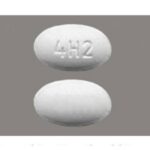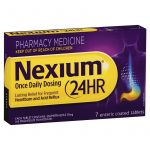What Drug is the Purple Pill?

What drug is the purple pill?
The “Purple Pill” or Nexium is a brand of esomeprazole magnesium a proton pump inhibitor that decreases the amount of acid produced in the stomach. Nexium is used to treat symptoms of gastroesophageal reflux disease (GERD) and other conditions involving excessive stomach acid such as Zollinger-Ellison syndrome. It is also used to promote the healing of erosive esophagitis (damage to your esophagus caused by stomach acid).
Nexium may also be given to prevent gastric ulcers caused by infection with Helicobacter pylori (H. pylori), or by the use of nonsteroidal anti-inflammatory drugs (NSAIDs). Nexium is not for immediate relief of heartburn symptoms.
How the purple pill (Nexium) works
Esomeprazole magnesium belongs to a class of drugs called proton pump inhibitors. A class of drugs is a group of medications that work in a similar way. These drugs are often used to treat similar conditions.
Nexium decreases the amount of acid your stomach produces. It works by blocking the proton pump in the stomach’s cells. When the proton pump is blocked, your stomach makes less acid.
How is the purple pill (Nexium) used?
Use Nexium exactly as directed on the label, or as prescribed by your doctor. Take each dose with a full glass (8 ounces) of water.
Nexium should be taken at least one hour before a meal. Do not crush or chew a delayed-release capsule. However, to make swallowing easier, you may open the capsule and sprinkle the medicine into a spoonful of pudding or applesauce. Swallow right away without chewing. Do not save the mixture for later use.
The capsule can be given through a nasogastric (NG) feeding tube. Read and carefully follow any Instructions for Use provided with your medicine. Ask your doctor or pharmacist if you do not understand these instructions.
Esomeprazole is usually given for 4 to 8 weeks only. Your doctor may recommend a second course of treatment if you need additional healing time.
Use this medicine for the full prescribed length of time, even if your symptoms quickly improve.
Call your doctor if your symptoms do not improve or if they get worse while you are taking this medicine.
This medicine can affect the results of certain medical tests. Tell any doctor who treats you that you are using esomeprazole.
Some conditions are treated with a combination of esomeprazole and antibiotics. Use all medications as directed.
What are the side effects associated with using the purple pill?
Common side effects of the purple pill include:
• Abdominal/stomach pain
• Constipation
• Diarrhea
• Dizziness
• Drowsiness
• Dry mouth
• Gas (flatulence)
• Headache
• Indigestion
• Itching
• Nausea
• Nervousness
• Rash
• Vomiting
Less common side effects of esomeprazole include:
• Anaphylactic reaction/shock
• Blood and lymphatic system disorders: Agranulocytosis, pancytopenia
• Blurred vision
• Breast enlargement in males
• Bronchospasm
• Gastrointestinal (GI) candidiasis
• GI disorders: Pancreatitis, stomatitis, microscopic colitis
• Hepatobiliary disorders: Liver failure, hepatitis with or without jaundice
• Interstitial nephritis
• Low blood magnesium (hypomagnesemia)
• Musculoskeletal disorders: Muscular weakness, muscle pain, bone fracture
• Nervous system disorders: Hepatic encephalopathy, taste disturbance
• Psychiatric disorders: Aggression, agitation, depression, hallucination
• Skin and subcutaneous tissue disorders: Hair loss, erythema multiforme, hyperhidrosis, photosensitivity, Stevens-Johnson syndrome, toxic epidermal necrolysis (sometimes fatal)
Postmarketing side effects of Nexium reported include:
• Cutaneous and systemic lupus erythematosus
• Cyanocobalamin (vitamin B-12) deficiency
• Clostridium difficile-associated diarrhea
This document does not contain all possible side effects and others may occur. Check with your physician for additional information about side effects.
Drugs you should not use with the purple pill (Nexium)
Do not take these drugs with the purple pill (Nexium). Doing so can cause dangerous effects on your body. Examples of these drugs include:
- Clopidogrel. Esomeprazole can block clopidogrel from working in your body. If you need to take esomeprazole, your doctor may consider a different antiplatelet drug.
- Side effects from other drugs: Taking esomeprazole magnesium with certain medications raises your risk of side effects from these drugs. Examples of these drugs include:
- Diazepam. Esomeprazole magnesium can cause diazepam to build up in your body. This can cause more side effects from diazepam.
- Warfarin. Esomeprazole magnesium can increase the blood-thinning effect of warfarin. This can increase your international normalized ratio (INR) test results and prothrombin time. This interaction can increase bleeding and be fatal (cause death). If you need to take these drugs together, your doctor will watch you closely and may adjust your warfarin dosage.
- Cilostazol. Esomeprazole magnesium can slow the breakdown of this drug. This can increase the levels of cilostazol in your body. If you need to take these drugs together, your doctor will decrease your dosage of cilostazol.
- Digoxin. Esomeprazole magnesium can increase the levels of digoxin in your body. Your doctor may check your digoxin blood levels and adjust your digoxin dosage if needed.
- Methotrexate. Esomeprazole magnesium can increase the levels of methotrexate in your body. This may cause dangerous side effects. These side effects can include nausea, vomiting, headache, fatigue, and liver and kidney damage. If you need to take a high dose of methotrexate, your doctor may have you stop taking esomeprazole for a short time.
- Saquinavir. Esomeprazole magnesium may increase the levels of saquinavir in your body. This may cause more side effects from saquinavir. These may include fatigue, confusion, stomach and back pain, nausea, vomiting, and liver damage. Your doctor may watch you more closely and decrease your dosage of saquinavir if needed.
- Tacrolimus. Esomeprazole magnesium can increase the levels of tacrolimus in your body. This may cause high blood pressure and kidney damage. Your doctor may check your tacrolimus levels and adjust your dosage if needed.
- Side effects from esomeprazole magnesium: Taking esomeprazole magnesium with certain medications raises your risk of side effects from esomeprazole. This is because the amount of esomeprazole in your body is increased. Examples of these drugs include:
- Voriconazole. Voriconazole can double the levels of esomeprazole magnesium in your body. Your doctor may decrease your dose of esomeprazole. They may be more likely to lower your dosage if you have Zollinger-Ellison’s syndrome and take a high dosage.
- Clarithromycin.
- When other drugs are less effective: When certain drugs are used with esomeprazole magnesium, they may not work as well. This is because the amount of these drugs in your body may be decreased. Examples of these drugs include:
- Certain antiretrovirals, such as atazanavir and nelfinavir. Esomeprazole magnesium may keep you from absorbing these drugs well. This means that they won’t work to treat your virus. You shouldn’t take esomeprazole with these drugs.
- Mycophenolate mofetil. Esomeprazole magnesium may change the balance of your stomach acid. This may decrease how well you absorb mycophenolate mofetil. It isn’t known how this will affect your transplant. Ask your doctor whether it’s safe for you to use these drugs together.
- When esomeprazole magnesium is less effective: When esomeprazole magnesium is used with certain drugs, it may not work as well to treat your condition. This is because the amount of esomeprazole in your body may be decreased. Examples of these drugs include:
- St. John’s wort. You shouldn’t use these drugs together.
- Rifampin. You shouldn’t use these drugs together.
further, decrease your low magnesium levels. Your doctor may give you magnesium supplements and monitor your magnesium levels.
For people with a vitamin B-12 deficiency: Taking this drug for two to three years can decrease vitamin B-12 levels in your blood. This can further decrease your low vitamin B-12 levels. Your doctor may give you vitamin B-12 injections and monitor your vitamin B-12 levels.
For people with osteoporosis: Using this drug every day for a long time can increase your risk of hip, wrist, or spine fractures.
For people with plans to have neuroendocrine tumor test: This drug can change the balance of your stomach acid. This may cause a test for neuroendocrine tumors to be positive when there isn’t a tumor.





